
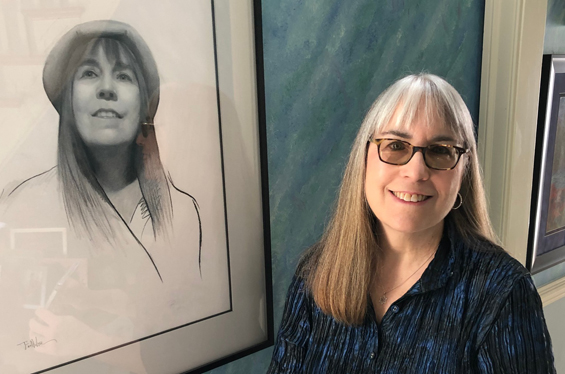
photo: Lori Laitman
FRESH PATTERNS: THE MUSIC OF LORI LAITMAN
WHEN EARLIER this year Indianapolis Opera presented Lori Laitman's theatrical oratorio Vedem (in a world premiere double bill with Hans Krása's Brundibar), the company's general director, David Craig Starkey, introduced her as “one of the most successful female composers in our country.” She's also often referred to as one of today's premiere art song composers, and certainly that's borne out by the superior calibre of the hundreds she's written and the acclaim they've received; The Journal of Singing, for example, has made note of “her unerring instincts for setting texts with sensitivity and grace.” When the operas and choral pieces she's created are factored into her total output, the work she's created is as staggering and boundless as her imagination.
How the Potomac, Maryland-based composer came to focus on art song is a fascinating story unto itself. Born into a musical family in 1955, Laitman, perhaps spurred on by albums she heard on the family record player (Prokofiev's Peter and The Wolf one of many fondly remembered), began creating songs as a child and started piano lessons at five and flute two years later. Graduating early from high school, she attended Yale and, inspired by the aspiring composers around her, began thinking she too might try her hand at writing music. An early crossroads of sorts arose when at the end of her sophomore year she had to choose between studying in France with Nadia Boulanger (as had her two sisters) or studying flute at Interlochen Music Camp in Michigan. Daunted by the prospect of working with the famous teacher, Laitman chose camp, a decision that would ultimately prove life-changing when her roommate, future soprano Lauren Wagner, later helped catalyze Laitman's development into an art song composer. Back at Yale, she focused on composing instrumental material but also took a graduate course taught by Frank Lewin about writing music for film and theatre. “The techniques I learned in his class,” she recalls, “are ones I still use today, and I often view my poems in a theatrical way.” In fact, her initial compositional focus was on writing for film and theatre, an example being the score to The Taming of the Shrew she produced in 1980 for Washington's Folger Theatre.
After graduating magna cum laude with honours in music from Yale College and receiving her Master's in Music in flute performance from the Yale School of Music, she married her college beau, Bruce Rosenblum, and moved with him to Williamstown, Massachusetts, where both taught at a small private high school and she played flute with the Vermont Symphony. Sundry professional and personal accomplishments followed, including the birth of three children, James, Diana, and Andrew, until Wagner called in 1991 to ask if she'd consider writing songs for her debut CD. Flattered yet unsure about whether she could satisfy the request, Laitman perused her local library's poetry collection and chose Sara Teasdale's “The Metropolitan Tower” as text to use for the song. “Almost immediately I realized that I had a facility for setting words to music,” she says. “I also felt the quality of my songs far surpassed that of my previous compositions.” Her instincts were sound: that first art song would eventually be described by The Journal of Singing's Gregory Berg as “nothing less than a masterpiece.” On December 16th, 1991, “The Metropolitan Tower” was premiered by Wagner with pianist Frederick Weldy at Merkin Hall in New York and subsequently appeared on both her American Song Recital and Laitman's own Mystery, issued in 2000 on Albany Records and the first album comprised entirely of her compositions. That initial commission by Wagner opened the art song floodgates, so to speak.
Laitman's compositional approach is fastidious, methodical, and precise. For her, words are paramount, and every musical choice follows from them. After a poem is selected, the focus shifts to crafting musical material to complement the text and its stresses. Operating in service to the poet's creation, Laitman develops leitmotifs and word painting techniques to illuminate and amplify its meanings. Once the vocal line is done, consideration is given to harmonies that are often separate from it in order to amplify the text from a different angle. Space, texture, rhythm, and tempo all enter into a process that gradually crystallizes into an intricate, multi-layered tapestry. “For me,” she says, “the combination of melody and words are like two strands of DNA combining to form a unique whole. And when the melody is separated from the words and used independently, I feel that the music still retains the imprint of the meaning of the words.”
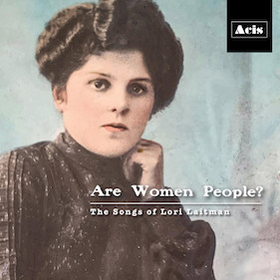
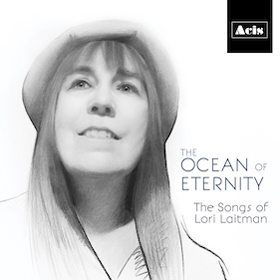
The foundation for her art songs is voice and piano, but, as a scan of her discography reveals, other combinations are also used. The singer might be paired with a saxophonist, violinist, cellist, or even chamber ensemble; in every case, it's the text that influences arrangement decisions. Naturally, she's drawn to poets whose writings personally resonate. Emily Dickinson, Mary Oliver, Joyce Sutphen, Dana Gioia, and Teasdale are ones she often gravitates to as their texts dovetail fluidly with her lyrical style. A frequent collaborator for her long-form works, on the other hand, is David Mason, who created the librettos for The Scarlet Letter, Vedem, and Ludlow.
That vocalists and instrumentalists love performing her material is easy to understand. The lyrical melodies that soar through the songs—see “If I …” from Four Dickinson Songs and the three-part Fresh Patterns on The Ocean of Eternity as examples—offer performers magnificent material with which to work. Soprano Laura Claycomb, whose glorious performance as Hester Prynne distinguishes the Naxos recording of The Scarlet Letter, says about working with her, “I'd heard people speak highly about Lori before I saw the opera score, and their praise was well deserved, I found, when I saw the music. The score I received was beautiful, but when I determined that it hung out a bit low for my voice, she rewrote parts to suit it. The high note at the end of the lullaby was my suggestion, and she developed it so it made sense dramaturgically. If you look at the score as it's now officially printed, she created multiple options for different notes for the soprano throughout the aria, so that it opens up the road to different interpretations and can bring out each artist's strengths within the same role. Not everybody can hang out on a pianissimo high C at the end of a breath line, but they can do other beautiful things that are perhaps not in my wheelhouse. Having a true collaboration like we did with the composer was amazing.”
Fellow composers are as fulsome in their praise. “Lori is an unusually generous, loving, humble, and supportive colleague who seems to be everyone's cheering squad,” says Ricky Ian Gordon, whose songs appear with Laitman's on Stephen Powell's 2021 Grammy-nominated American Composers at Play and whose output likewise includes operas and a voluminous catalogue of art songs. “She has enormous integrity, writing tirelessly and putting tons of excellent work out into the world. She, like so many others, is a tribute to this historic explosion of women composers, which just makes this ecosystem of composers so much healthier.” Tom Cipullo, a renowned NY-based composer of numerous song cycles, operas, and orchestral and chamber works and whose chamber opera After Life appears alongside her In Sleep the World is Yours on the 2016 Naxos American Opera Classics release, says, “I'm amazed by the emotional range of Lori's music. Is there another living composer whose works so convincingly span such a wide array of feelings and states of mind? And I marvel also at those glorious, lyrical melodies that adhere so closely to every nuance of the written word. Lori's voice, at once free and yet so superbly controlled, is unlike anyone else working today. Lori Laitman is a national treasure.”
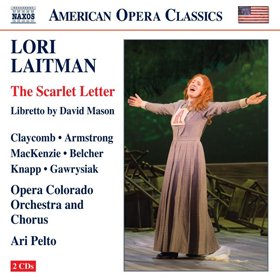
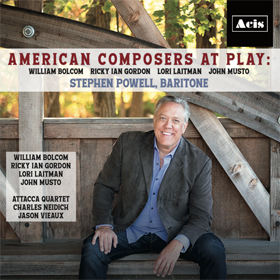
Fortunately for listeners, much of that output is available in recorded form, with releases on Albany, Naxos, Acis, and others making up a voluminous discography. A number are art song collections, including Mystery, Dreaming (2003), Becoming a Redwood (2006), Within These Spaces (2009), and the double-CD set Living in the Body (2019). Of late she's found a terrific home on Acis, which issued Holocaust 1944 in 2013 and the song collections Are Women People? and The Ocean of Eternity in 2021 and 2022, respectively.
Asked if there are particular works she believes she's realized most perfectly, Laitman replies, “It's hard to choose, but here are a few. When I wrote “The Metropolitan Tower” in 1991, I was embarrassed by its strophic nature and simple melody. But now I count it among my favourites, for those very reasons (and the fact that it launched my career). “If I…” was written as an eightieth birthday present for my father, who lived to be almost 100. I consciously tried to create a beautiful melody that he would enjoy and this particular song just ‘flew' out of me. It has become one of my most popular songs, and every time I hear it, I think of him. Another is “The Old House,” the last of my I Never Saw Another Butterfly cycle (1995), to a poem by Franta Bass. When I was writing the song's opening, I was worried that having the saxophone repeat the same note was not going to be interesting enough for saxophonist Gary Louie—but I went with it as I kept wanting to hear the sound of a bell tolling. The song has such power, particularly the phrase “What a waste of hours,” which always gives me goosebumps. From Becoming a Redwood, there's “Pentecost,” the setting of a Dana Gioia poem that was extremely personal for him, as it was about the death of his first-born son from SIDS. I wanted to be sure to capture the emotional content adequately, to honour the words. I used a lot of repetition in the accompaniment to create a haunting, hypnotic effect to underscore the way that one must go through life (at least for a while) after such a horrible tragedy.” Others she cites include “Men with Small Heads,” "Sarong Song,” “The Apple Orchard,” “The Sunflowers,” “Early Snow,” “Incident,” and “Peter and the Wolf with Jason, Aged Three.” “And of course,” she adds, “I'm very proud of my operas. It's a years-long commitment to write one—but wonderful once you see your characters up on stage.”
With such an abundance of song collections from which to choose, it might be hard for the listener new to Laitman's music to know where to start. Of course every release rewards one's time and attention, but the two recent Acis sets provide superb entry-points for the diversity of their material. Are Women People? augments multiple world premiere recordings (including the title work, which sets texts by Susan B. Anthony and from The U. S. Constitution to music) with a new treatment of Days and Nights; The Ocean of Eternity likewise complements world premiere recordings of the title work and Dear Edna with four selections from Vedem Songs and two excerpts from Ludlow. The Naxos recordings of the oratorio Vedem and opera The Scarlet Letter are also excellent exemplars of her long-form writing.
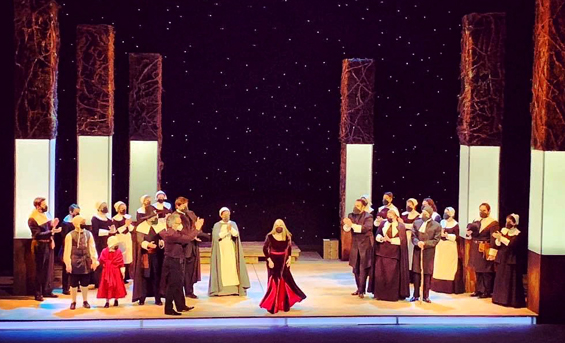
Laitman taking the stage following a February 2022 performance of The Scarlet Letter at The University Of Oklahoma
A particularly important part of her output has to do with material relating to the Holocaust, with some of the projects commissions by Music of Remembrance. As expected, her treatments are handled with respect and sensitivity. “For a subject as important and horrific as the Holocaust,” she states, “I find that music is the perfect vehicle for telling the stories of those who experienced it—the music both amplifies the emotions but also helps to cushion the effect of the horror. It's so important to share these stories, both to increase empathy and to honour those who are no longer with us.” That interest was in place from the very start of her career as an art song composer, as evidenced by the inclusion of I Never Saw Another Butterfly on Mystery. Other works relating to the topic include: Holocaust 1944, a powerful song cycle performed by bass-baritone Dashon Burton and double bassist Logan Coale on the 2013 Acis release; The Seed of Dream, issued with Jake Heggie's For a Look or a Touch and Gerard Schwarz's In Memoriam on Naxos American Classics (2008); the aforementioned Naxos American Opera Classics recording of her In Sleep the World is Yours and Cipullo's After Life; and the oratorio Vedem, released with the shorter Laitman work Fathers on Naxos American Classics (2011).
Asked what originally compelled her to begin writing material on the topic, Laitman replied, “In 1995, Lauren Wagner suggested I compose a song cycle for her using poetry from I Never Saw Another Butterfly, a book containing drawings and poems from children imprisoned by the Nazis in the Terezin Concentration Camp during WWII. I was intrigued by the sincerity and depth of these poems and wound up choosing six. I scored the work for the unusual combination of soprano and alto saxophone for two reasons: I wanted Lauren to meet saxophonist Gary Louie and felt that the timbre of the saxophone might provide the perfect haunting sound to accompany these words. I subsequently created additional versions—one for soprano and clarinet, and one for soprano with bassoon. Each version preserved the reedy sound that I desired—although unofficially, this cycle has been performed with a variety of other instruments, including flute, bass clarinet, English horn, and even tuba. Interestingly, my then-publisher rejected the work, predicting that no one would want to perform a piece for only soprano and saxophone. The publisher was wrong, and this cycle has become one of my most performed works and the most recorded.
“After the premiere with Lauren and Gary, the great late baritone Sanford Sylvan heard a recording of it and contacted me, suggesting I write more for voice with one instrument. So I composed my second Holocaust-themed work, Holocaust 1944, which sets seven poems by adults poets who were either killed or whose lives were completely altered by the Holocaust. I scored the work for baritone with double bass, dedicating it to Sylvan and the great bass player Gary Karr. The darker colours of the voice and bass suited the darker nature of these poems. Around 2000, I started working with Music of Remembrance, a Seattle-based group dedicated to performing music from the Holocaust and to creating new works about it. They've commissioned several from me: Fathers (2003); The Seed of Dream (2005), Vedem (2010), In Sleep The World Is Yours (2014), and my latest commission, Wertheim Park (2022).”
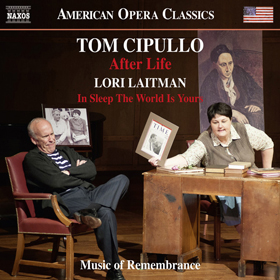
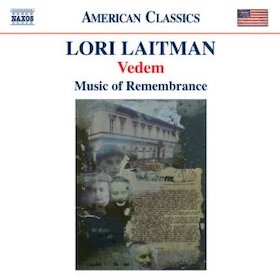
Opera also looms large in Laitman's creative world. Among those she's composed are The Scarlet Letter (the terrific Naxos recording was deemed one of the top five CDs of 2018 by Fanfare), The Three Feathers (her Grimm's fairy tale-based children's opera with librettist Gioia), and Uncovered (her one-act chamber opera set to Leah Lax's libretto based on her memoir). Of The Scarlet Letter, Gramophone wrote, “The first thing that leaps into one's ears is the sheer beauty of the music …and her ability to meld words with lyrical, often soaring lines is on abundant display.” She's currently working with Mason to complete Ludlow, an opera the two initiated in 2012 that alternates between the 1914 Colorado mining-town disaster and the present day.
Given that the art song and opera are such different creatures, the question arises as to whether she adjusts her approach for one versus the other. “I use the same process, in that the words guide me,” she says. “I think of my songs as miniature operas (or miniature films) and my operas as very large songs. But in opera, of course, I have characters to portray. I try to create musical lines that are distinctive for each character and that showcase the psyche of each character (this is not always applicable in an art song). Timbre, which is generally not that important to me in my art songs, is of utmost importance in my operas. And leitmotifs, which I often use in song, are essential in the operas, to help unify the larger structure. Orchestration is also so important in the opera, and adds yet another layer of interpretation.
"I think of writing an opera as akin to weaving a large oriental rug. The details have to be beautiful, not only in a small area but for the entire rug. It has to be constructed well enough to last. Writing the last scenes of an opera is definitely difficult—because threads that were used earlier must be pulled into the musical picture but often in a new setting. It takes patience to figure it all out, but in the end, it all comes back to honouring the words, and it's thrilling to see how different performers bring out different aspects of your own music.”
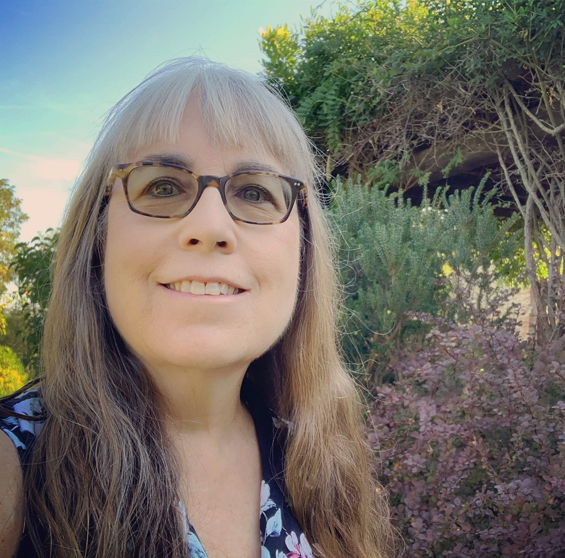
photo: Lori Laitman
As serious as much of her music is, humour, playfulness, and irreverence emerge too. Some songs exude a theatrical character, a quality consistent with her affection for works such as Into the Woods, Candide, and Hamilton. Examples of that lighter side are plentiful: “Over the Fence” and “Wild Nights” (from Days and Nights, included on Mystery), “Men With Small Heads” and “Dreaming” (on Dreaming), “Money” (from Within These Spaces), and the four-part Short Songs for Edward, composed for her two-year-old grandchild in 2015 and its tone intimated by the titles “Sometimes You Get a Boo-Boo” and “Please and Thank You” (included on Living in the Body).
The presence of that theatrical dimension in her music prompts another question, this one having to do with where the dividing line between classical and theatrical material lies. Porgy and Bess is an opera, yes, but it also could be presented as a Broadway production, and the converse might be said of West Side Story. “The difference for me,” she says, “is in the structural response to the text, as well as whether music is sung all throughout the production or whether music is intermittent (as in West Side Story). With musical theatre songs, often the music is more strophic and simple than a vocal line found in an art song or opera. Proper musical stresses don't seem to be as valued as perhaps landing on a high note at the end of a word or phrase (not something I would recommend for art song). There's obviously great musical theatre and great opera—as well as bad musical theatre and bad opera. It all depends on the skill of the composer and lyricist and how the words and music mesh. Ideally, the text and music should combine into a perfect blend that is greater than its parts.”
As is not unusual for living composers, some Laitman works have been publicly performed but not yet commercially recorded. A recent example is The Imaginary Photo Album, commissioned by the BBC and The Royal Philharmonic Society for soprano Katharina Konradi and premiered in October 2020 at Wigmore Hall in London with pianist Joseph Middleton. A song cycle about childhood, The Imaginary Photo Album features music set to poems by A. E. Stallings, Eugene Field, and Joyce Sutphen (the work's title is taken from the latter's poem), with all viewing childhood from a mother's perspective. Each song exemplifies Laitman's compositional approach: whereas “Listening to Peter and the Wolf with Jason, Aged Three” weaves quotations from Prokofiev's work into her music, “Little Blue Pigeon” uses a 9/8 metre to create the rocking feel of a lullaby. Ludlow, her opera with David Mason, isn't available yet as a full recording either, though two excerpts from it appear on The Ocean of Eternity.
To clarify her compositional approach and how she moves from the text to the finished song, she uses “Ultrasound” (set to to a poem by Stallings and from The Imaginary Photo Album) to illustrate. “It would be too much to detail every thought (if I could even remember—although sometimes I will write notes to myself in the music to remind me of my thought process at the time). The opening words are: “What butterfly — / Brain, soul, or both — / Unfurls here, pallid / As a moth?”:
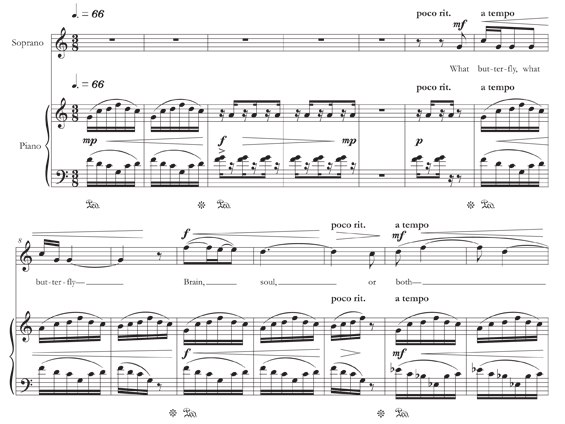
“The song has a quick pace throughout, underscoring the quickness of the fetal heartbeat. The words ‘What butterfly' gave me the idea to use word painting in the accompaniment: the metaphorical imagery of a butterfly is found in the opening piano gesture, as the treble and bass expand and contract in contrary motion before resting on repeated pitches (as if watching a butterfly fly). A motivic cell, set to the interval of a fourth, pervades the piece, and is first heard with the opening words ‘what butterfly.'
“When the poem references the quick fetal heartbeat, I use very quick repeated notes, like a beating heart, in the voice and piano, to musically paint that image:
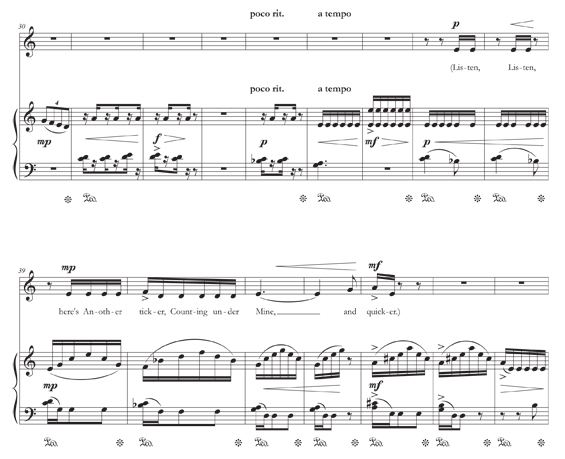
“Here I use descending runs to paint the image of ‘Spine like beads / Strung on a wire':
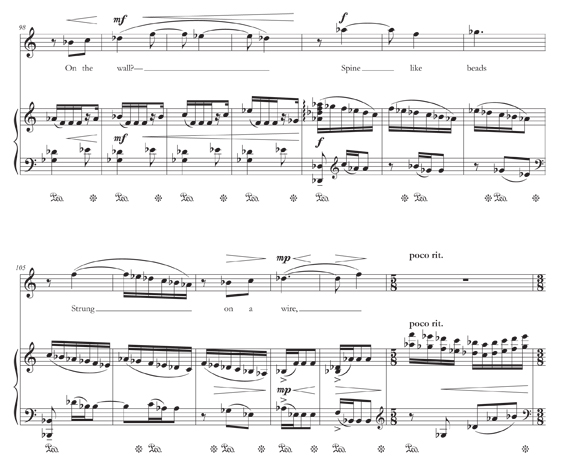
“I work with pencil and music paper, generally at the piano. Everything is very sloppy, although I try to always write at least the initials of the song I'm writing and the date so I can keep track of when and where. It's a big day when I've gotten this ‘mess' of ideas done and can finally transfer the notes to the computer. And from there I keep working, making different versions, until I feel I've reached the final product. I know when it's done when I want to just listen over and over to the piece and don't feel the need to do anything more. When I've sometimes returned to do revisions on songs, the changes are mainly in the accompaniment—using the piano in a more orchestral way than originally written. Sometimes, I'll also create a bit more space for the voice to be even more independent. And over the years, and through writing the operas, I've also let the voice sing a cappella for extra dramatic effect.”
As mentioned, Laitman comes from a musical family. Her mother was a pianist, violinist, and singer, and Lori's sisters were musicians too, one a violinist and the other a pianist. That has carried over into her own family: Laitman's oldest son, James Rosenblum, is a lawyer and pianist, and concertizes extensively with his wife Ana Glig; Andrew, her other son, is an internationally acclaimed pianist and harpsichordist whose piano playing graces Are Women People? and The Ocean of Eternity, and his wife, Maria Sumareva, also plays piano on Are Women People? (Laitman herself says, “Honestly, I don't think that any pianist can play my music with more sensitivity than Andrew, and he far surpasses me”). Lori's daughter, Diana Rosenblum, recently completed her doctorate in music composition at Eastman, and Diana's wife, Tze-Wen (Julia) Lin, is also a pianist who plays on The Ocean of Eternity on Vedem Songs. Such personal connections make listening to Laitman's recordings an all the more rewarding and vivid experience. The body of work she's produced testifies to her stunning artistic gifts and presents an invaluable cumulative portrait of contemporary art song at its finest. How lucky we are to have her.
Website: LORI LAITMAN
June 2022![]()